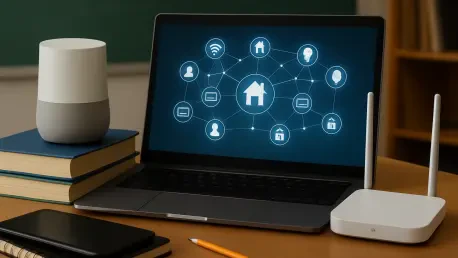Unveiling the Digital Revolution in Learning Environments
Imagine a classroom where every student’s needs are met in real time, where campus operations run seamlessly with minimal human intervention, and where learning transcends physical boundaries through connected technologies. This is not a distant dream but a tangible reality being shaped by the Internet of Things (IoT) in education. The market for IoT solutions in educational settings is on a remarkable ascent, with projections estimating a staggering valuation of $68.3 billion by 2033. This analysis aims to dissect the forces driving this growth, explore transformative trends, and evaluate the challenges that could impact this trajectory. By delving into market dynamics and regional disparities, the purpose is to provide stakeholders with actionable insights into how IoT is redefining education on a global scale.
Market Dynamics and Growth Trajectory
Soaring Projections and Key Catalysts
The IoT in Education Market is experiencing unprecedented momentum, with its current valuation pegged at approximately $15.4 billion in 2025, set to skyrocket to $68.3 billion by 2033. This translates to a robust Compound Annual Growth Rate (CAGR) of 18.4% over the forecast period. Such growth is fueled by a surge in demand for digital tools that enhance learning outcomes and operational efficiency. Educational institutions are increasingly recognizing IoT’s capacity to personalize education and streamline administrative tasks, a trend amplified by the global shift toward hybrid and remote learning models. Government initiatives supporting smart education infrastructure further bolster this expansion, positioning IoT as a cornerstone of modern educational frameworks.
Personalization as a Game-Changer
A pivotal driver of IoT adoption in education is its ability to tailor learning experiences to individual student profiles. Smart technologies, such as IoT-enabled Learning Management Systems (LMS) and wearable devices, facilitate real-time tracking of academic progress, allowing content to adapt dynamically to diverse learning paces. For instance, interactive displays in classrooms can modify lessons based on immediate student input, enhancing engagement. Market data highlights a significant uptick in investments targeting personalized learning tools, reflecting their value in boosting educational outcomes. However, the high cost of deploying such systems and concerns over student data privacy pose notable obstacles that institutions must navigate to fully capitalize on these innovations.
Operational Efficiency Through Connected Campuses
Beyond enhancing learning, IoT is revolutionizing campus management by integrating systems for energy optimization, security, and resource allocation. Smart sensors in university facilities can reduce energy consumption by adjusting lighting and heating based on occupancy, while IoT-driven attendance systems automate routine administrative duties. Pilot projects in North American institutions demonstrate substantial cost savings and improved safety through these connected solutions. Yet, the risk of cyberattacks remains a critical concern, as breaches could compromise sensitive information. Balancing operational advancements with robust cybersecurity protocols is essential for sustaining trust and scalability in IoT implementations.
Emerging Trends and Future Outlook
Cloud-Based Solutions Leading the Charge
One of the most prominent trends shaping the IoT in Education Market is the shift toward cloud-based platforms. These solutions offer unparalleled scalability and flexibility, making them ideal for supporting remote learning environments that have become integral to education. Cloud integration allows institutions to update systems effortlessly and access data from anywhere, a feature that proved invaluable during global disruptions in recent years. As technology continues to evolve, the fusion of cloud with IoT is expected to drive further innovation, enabling seamless connectivity across diverse educational settings and paving the way for broader accessibility.
AI and Machine Learning Synergies
The convergence of IoT with artificial intelligence (AI) and machine learning (ML) is set to amplify its impact on education. These technologies enhance IoT’s capabilities by enabling predictive analytics for student performance and deeper customization of learning materials. For example, AI-driven IoT systems can anticipate learning gaps and suggest targeted interventions, improving academic success rates. Market forecasts suggest that such integrations will become mainstream by the end of the forecast period, transforming classrooms into data-rich environments. Regulatory frameworks around data usage will play a crucial role in determining the pace of this adoption, as institutions prioritize compliance alongside innovation.
Regional Disparities and Growth Hotspots
Geographic variations significantly influence the IoT in Education Market’s expansion. North America dominates with its advanced technological infrastructure and substantial investments, particularly in the United States, which holds a leading market share. Meanwhile, the Asia-Pacific region is emerging as a growth hotspot, propelled by vast student populations and supportive digital policies in nations like China and India. Conversely, regions such as South America and the Middle East & Africa grapple with limited access to technology and funding constraints, slowing adoption rates. Tailored approaches, including public-private partnerships, are vital to address these disparities and ensure that IoT’s benefits are equitably distributed across global markets.
Reflecting on the Path Forward
Looking back, the analysis of the IoT in Education Market reveals a transformative journey that has reshaped learning and operational landscapes, reaching a projected valuation of $68.3 billion by 2033. The exploration of growth drivers, innovative trends, and regional dynamics underscores IoT’s potential to create more inclusive and efficient educational systems. For stakeholders, the next steps involve prioritizing strategic investments in scalable, secure IoT solutions while fostering collaborations to mitigate costs and expertise gaps. Educational institutions are encouraged to initiate pilot programs to test impact, while policymakers need to establish clear data protection guidelines to build trust. Moving forward, the focus must remain on leveraging IoT to bridge accessibility gaps, ensuring that technology serves as an enabler of education for all, regardless of socioeconomic barriers.









